Costa Rica News – The Ministry of Justice will save ¢6 million a year (About $12,000) for every prisoner who leaves the prison with an electric bracelet, whether it be because the judge took cautionary measures or because house arrest was the agreed sentence.
 The plan to release offenders who didn’t pose a threat to the public was passed in a second debate in the Legislative Assembly on the 17th September. All that remains is that the President Luis Guillermo Solís puts it into effect and it is published in La Gaceta.
The plan to release offenders who didn’t pose a threat to the public was passed in a second debate in the Legislative Assembly on the 17th September. All that remains is that the President Luis Guillermo Solís puts it into effect and it is published in La Gaceta.
According to a report presented by the Minister for Justice, Cristina Ramírez, in June before the Full Legislative Commission the current figures are as follows: One day in prison costs $48 per prisoner, whereas the daily cost for the bracelets ranges from $11-$25 (averaging around $18).
That means that keeping one person in prison for a year costs the State ¢9,5 million. Having them ‘disinstitutionalized’ with the electronic device makes a saving of ¢6 million.
The proposal. With this plan, as laid out by contributions from the Public Defence, they are hoping to standardize the use of the electronic bracelet or anklet as an alternative to preventative arrests, a substitute for a fixed prison sentence or as the sentence itself.
According to the text, as previously studied, those who can leave are first time criminals with a six month sentence or less, women in advanced stages of pregnancy, housewives with children under 12 years old and people with disabilities.
This will also benefit prisoners with physical, addictive or mental illnesses, or those with illnesses whose treatment can’t be administered in prison.
The bracelet will also be given to those under security measures for domestic violence so that the policing bodies can be alerted if they get close to their victims.
Excluded cases are: prisoners with links to organized crime, those charged with sexual offences to minors, those charged with using firearms, previous offenders and those considered to be particularly dangerous.
In use. When are the bracelets going to start being used? La Nación tried to talk to Minister Ramírez about the date the plan would come into effect, the 2015 budget and the proposal for making the project operational, but she said that she was not answering questions.
The representative for the Citizens’ Action Party (PAC), Víctor Morales, who presided over the Comisión Plena Tercera, said that there would be a trial run with a budget of $1 million in credit from the Banco Interamericano de Desarrollo (BID).
The Ministry of Justice say that the money will be used to apply measures to 150 prisoners to start with.
In its provisional phase (for the first year), the bracelet will just be used as a cautionary measure.
When the program is fully functioning, they will have to develop implementation protocols, as well as a police response if the prisoner goes against the judge’s conditions or tries to remove the bracelet.
If that were to happen, all Police staff across the country are obliged to work together to detain the criminal and to bring them before a judge for the bracelet (and its privileges) to be removed.
The General Body for Social Adaptation will be charged with the responsibility as the vigilance centre – no-one has yet ascertained whether this will fall to private business or to the institution.
Morales maintained: “Having freedom is a reality in society, and we have to make a decision whether these subjects, for having committed crimes in certain situations, can have some sort of social exclusion for their mistakes.”
“This legislation marks a difference, because we are prepared to treat them differently due to their character or behaviour. Without a doubt, these devices are an advancement”, he said.
Marta Iris Muñoz, Director of the Public Defence, said “Our responsibility will be to refer these cases to the judge. We will start with a trial run looking more at the person’s profile than the nature of their crime. We’ll look at the life-plan of every single one; for example, their family support, their socioeconomic stability, their options for further study, for work and any treatment for drugs they’re taking.
Anyone who leaves will be under strict control by a number of different entities, and the judge. In front of witnesses, they will work with the District Attorney’s office so that all these conditions may be evaluated.”
Translated by Leah Hendre from La Nacion

